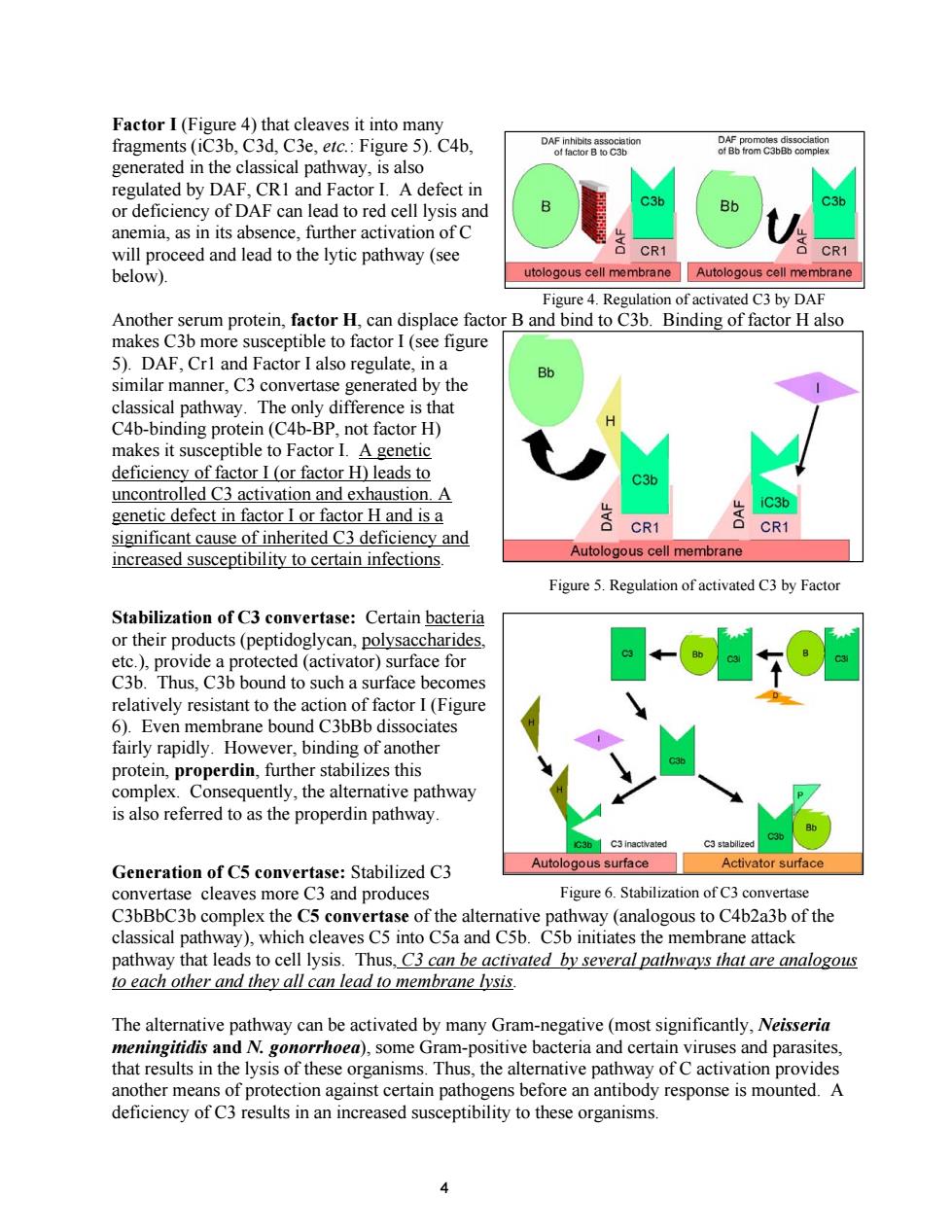正在加载图片...

Factor I(Figure 4)that cleaves it into many fragments(ic3b,C3d,C3e,etc.:Figure 5).C4b, 8WemC2e generated in the classical pathway,is also regulated by DAF,CRI and Factor I.A defect in or deficiency of DAF can lead to red cell lysis and Bb anemia.as in its absence.further activation of C will proceed and lead to the lytic pathway (see CR1 CR1 utologous cell membrane Autologous cell membrane AmeepoenactorLcadipaectorBandbdibCsbBdgOfSCbH ctiva DAF.Cr ceptble to fact I(see figure d Factor I also regulate, in a milar manner,C3 convertase generated by the classical pathway.The only difference is that C4b-binding protein(C4b-BP,not factor H) makes it susceptible to Factor I.A genetic deficiency of factor I (or factor H)leads to uncontrolled C3 activation and exhaustion.A genetic defect in factor I or factor H and is a CR1 significant cause of inherited C3 deficiency and creased susceptibility to certain infections logous cell membra Figure 5.Regulation of activated C3 by Factor Stabilization of C3 convertase:Certain bacteria or their products(peptidoglycan,polysaccharides etc.),provide a protected(activator)surface for C3h Thus C3h hound to such a surface becomes relatively resistant to the action of factor I(Figure 6)Even membrane bound c3hBb dissociates fairly rap idly.However,binding of another protein,p operdin ther s this equently,the altemative pathway Is also referred to as the properdin pathway. Generation of c5 convertase:stabilized c3 cleaves more C3 and produces Figure 6.Stabilization of C3 convertase olex the C5 c ase fthe alte (an nalogous to C4b2a3b of the wa whi and C5b. initiate the em attack pathway tha at lea o cel hus,C can b activated by several pathways that are analogous to each other and they all can lead to membrane lysis. The alternative pathway can be activated by many Gram-negative(most significantly,Neisseria meningitidis and N.gonorrhoea),some Gram-positive bacteria and certain viruses and parasites, that results in the lysis of these organisms.Thus,the alternative pathway of C activation provides another means of protection against certain pathogens before an antibody response is mounted.A deficiency of c3 results in an increased susceptibility to these organisms Factor I (Figure 4) that cleaves it into many fragments (iC3b, C3d, C3e, etc.: Figure 5). C4b, generated in the classical pathway, is also regulated by DAF, CR1 and Factor I. A defect in or deficiency of DAF can lead to red cell lysis and anemia, as in its absence, further activation of C will proceed and lead to the lytic pathway (see below). Another serum protein, factor H, can displace factor B and bind to C3b. Binding of factor H also makes C3b more susceptible to factor I (see figure 5). DAF, Cr1 and Factor I also regulate, in a similar manner, C3 convertase generated by the classical pathway. The only difference is that C4b-binding protein (C4b-BP, not factor H) makes it susceptible to Factor I. A genetic deficiency of factor I (or factor H) leads to uncontrolled C3 activation and exhaustion. A genetic defect in factor I or factor H and is a significant cause of inherited C3 deficiency and increased susceptibility to certain infections. Figure 4. Regulation of activated C3 by DAF Figure 5. Regulation of activated C3 by Factor Stabilization of C3 convertase: Certain bacteria or their products (peptidoglycan, polysaccharides, etc.), provide a protected (activator) surface for C3b. Thus, C3b bound to such a surface becomes relatively resistant to the action of factor I (Figure 6). Even membrane bound C3bBb dissociates fairly rapidly. However, binding of another protein, properdin, further stabilizes this complex. Consequently, the alternative pathway is also referred to as the properdin pathway. Generation of C5 convertase: Stabilized C3 convertase cleaves more C3 and produces C3bBbC3b complex the C5 convertase of the alternative pathway (analogous to C4b2a3b of the classical pathway), which cleaves C5 into C5a and C5b. C5b initiates the membrane attack pathway that leads to cell lysis. Thus, C3 can be activated by several pathways that are analogous to each other and they all can lead to membrane lysis. Figure 6. Stabilization of C3 convertase The alternative pathway can be activated by many Gram-negative (most significantly, Neisseria meningitidis and N. gonorrhoea), some Gram-positive bacteria and certain viruses and parasites, that results in the lysis of these organisms. Thus, the alternative pathway of C activation provides another means of protection against certain pathogens before an antibody response is mounted. A deficiency of C3 results in an increased susceptibility to these organisms. 4